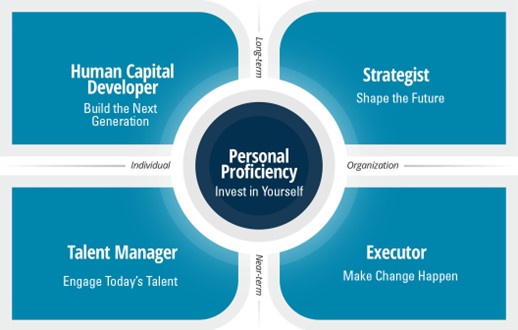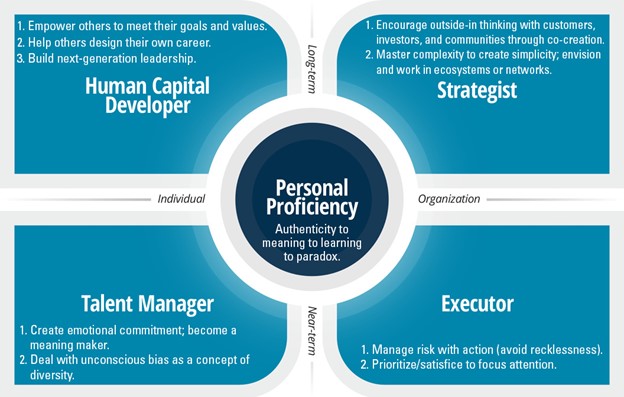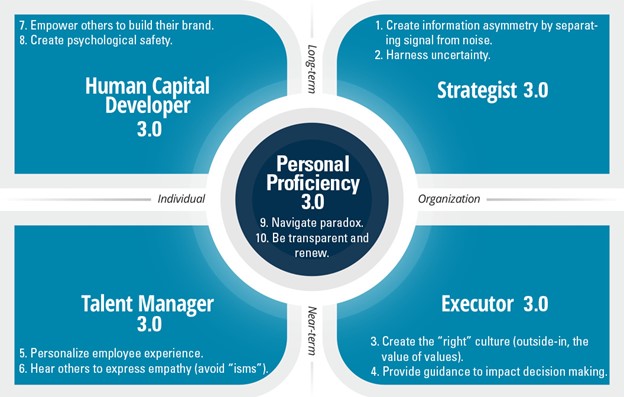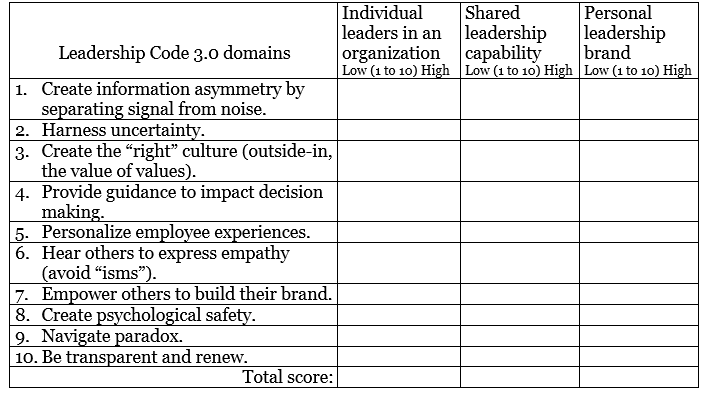Leadership 3.0 is both evergreen and ever-changing — Dave Ulrich's ten leadership requirements
- 7 Min Read
HR thought leader Dave Ulrich offers a ten-point leadership code to create better leaders, build shared leadership, and construct a personal leadership brand.
- Author: Dave Ulrich
- Date published: Nov 1, 2022
- Categories

No one can accurately predict the future, but it is possible to determine how to respond to whatever the future brings. Leadership responses to ever changing conditions ensure that leaders both stay the same and adapt. Staying the same means recognizing fundamental principles of leadership and adapting means engaging in ever-changing practices affiliated with those principles. This piece offers foundations of leadership that are evergreen and provides emerging skills fit for the future.
What are foundations of leadership to build on?
In 2009, Norm Smallwood, Kate Sweetman, and I published The Leadership Code and identified five domains of leadership competencies that leaders should master: strategist, executor, talent manager, human capital developer, and personal proficiency.
Leadership Code 1.0 (2009)

In fall 2017, we validated the five leadership domains and identified new critical skills in each domain for effective leaders.
Leadership Code 2.0 (2017)

What’s new in leadership to address current crises?
Now only a few years later, the concentrated challenges from the continual contextual changes reveal new leadership insights that lead to being better leaders, building shared leadership, and creating a personal leadership brand. Let me propose Leadership Code 3.0 to capture ten leader requirements for discovering and maximizing opportunities in crises.
Leadership Code 3.0 (October 2022)

Strategist: Shape the future — where are we going?
- Create information asymmetry by separating signal from noise
Technology has enabled digital distribution of information that inundates leaders through ubiquitous emails, zoom calls, Instagram posts, Twitter comments, and other information channels. Leaders need to discern signals from overwhelming information.
Signals are asymmetric information insights that have immediate and long-term consequences, and that inform decisions. Leaders who separate signal from noise focus on information that matters most and are both analysts with data and anthropologists with observations.
- Harness uncertainty
As new crises emerge, leaders face unprecedented uncertainty, not knowing with clarity what the context will be or how to definitively respond. Leaders fail either by promising false hope or by giving up hope. Harnessing uncertainty comes when leaders have realistic optimism about opportunities in today’s challenges and use uncertainty to reimagine or reinvent a positive future. These leaders tame apprehensions by facing fears, envisioning a better future, regulating expectations, and experimenting nimbly.
Executor: Make change happen — how do we get there?
- Create the “right” culture (outside-in, the value of values)
Culture has become a popular leadership agenda, almost becoming a catch-all panacea for organizational success. Most approaches to culture describe the underlying values of an organization that shape organization processes and leader behaviors. In these crises, culture can no longer just be descriptions of what is done but must focus on prescribing the “right” culture. The “right” culture connects internal values (and behaviors) with the value they create for external stakeholders (customers, investors, and communities).
Work boundaries are increasingly less about a physical “place” and much more about the values that create value for customers. As such, the right culture is the identity of the firm in the mind of customers, investors, and communities made real to all employees. Leaders focusing on the right culture combine purpose, values, brand, and culture into an integrated organizational agenda that helps organizations succeed in the marketplace and employees prosper in the workplace.
- Provide guidance to impact decision making
Digital information has enabled data analytics to move from scorecards/dashboards to insights to intervention to impact. Information impact comes when data informs which actions deliver the most value to key stakeholders (employees, business, customers, and investors).
The RBL Group and CorpU have partnered to create an organizational guidance system (OGS) that helps leaders discern where to invest limited resources to deliver desired results to all stakeholders. This OGS offers leaders data-based intelligence on how to upgrade talent, organization, leadership, and human resources.
Talent manager: Engage today’s talent — who goes with us?
- Personalize employee experiences (employee primacy)
Working from home with the pandemic crisis has affected people very differently. Frequently, younger employees who are usually digital natives might be expected to savor the virtual work world. However, they often have young children, live in smaller residences, or are single and seeking community, thus making the virtual work world challenging or unfavorable. These digital natives may prefer the traditional office so that they can focus on work and build career-enhancing relationships.
In a somewhat similar vein, the social unrest and racial injustice challenges have caused many to ponder on their personal biases as they seek to create a more inclusive and just society. From each of these crises, leaders need to be even more attuned to personal employee experiences. Leaders, as meaning makers, demonstrate sensitivity and responsiveness to unique employee experiences and desires so that employees find meaning from their work.
- Hear others to express empathy (avoid “isms”)
To create a better employee experience, leaders need to go beyond listening to hearing employees. Listening means that employees share information; hearing means that leaders receive that information with empathy. Empathic leaders eschew the many “isms” that filter thinking and action (e.g., racism, sexism, classism, elitism, ageism, and so forth) and help others feel appreciated for their unique talents and gifts.
The crises in our world have also created an emotional malaise that leaders need to appreciate. Being an empathic leader requires recognizing personal biases and malaise and modeling how to overcome them. When employees feel “heard,” they are more able to feel connected and then more able to contribute to a positive workplace that leads to marketplace success.
Human capital developer: Build the next generation — who stays when we go?
- Empower others to build their brand
Good leaders have personal stories to tell, and they share them well. But great leaders help others create and share their own stories. Even in the midst of a crisis, leaders need to empower the next generation of leadership by sharing information, building competence, delegating authority, and distributing rewards. The ultimate test of a leader is how the organization responds after the leader leaves. Empowering leaders savor their leadership posterity.
- Create psychological safety
Almost everyone has personally experienced both a safe and unsafe work setting. In these crises, leaders need to be even more focused on creating a safe environment for employees to share their personal and professional fears and anxieties. When employees can honestly share their concerns about emerging work requirements, social injustice, and career opportunities, employees feel heard and more connected to a community. Leaders create safe spaces by modeling values they expect of others.
Personal proficiency: Invest in yourself — how are you taking care of yourself?
- Navigate paradox
In our research, we have found that navigating paradox builds on the leadership skills of authenticity, emotional intelligence, and resilience (learning, grit). Leaders who navigate paradox respect others’ opinions, disagree without being disagreeable, and encourage divergence while being able to seek convergence.
In the crises, these leaders learn from what has been done before but also anticipate and create what can be done going forward. Leaders as paradox navigators appreciate the dialectic process as much as the result.
- Be transparent and renew
Ultimately, leaders model behaviors they hope others will follow. On recognizing the power of participative management, an executive leader proclaimed, “I am going to demand that my leaders practice participative management.” Wrong! You can’t demand participation.
Ultimately, leaders have to model what they want others to be, know, and do. Leadership hypocrisy leads to cynicism and loss of respect. In crises, leaders need to model transparency as they recognize their predispositions that they must renew to succeed.
Summary: Code 3.0 assessment
I am sure that I have overlooked many insights coming out of these perpetual crises. But as a starting list, these ten insights build on our Leadership Code research and may apply to an individual wanting to be a better leader, to all leaders creating a leadership capability throughout an organization, and to an organization creating personal leadership brand beyond the work setting. Indeed, crises are opportunities to lead.










